Final Project Proposal
Guitarists and other musicians who use analog and digital effects processors to manipulate the audio output of their instrument during a performance typically control these effects using knobs, dials, and switches on a control board. In the case of guitarists, this effects processing and control is usually handled via one or more effects pedals. Musicians often use their hands to make precise modifications to the settings of these processors before a performance and then manipulate them with their feet as they play to produce varying audio effects. For example a guitarist might have access to foot controls for volume, gain, and reverb, as well as switches to toggle specific pre-programmed effects.
I'm interested in looking at ways of moving some of this control away from the feet and onto the instrument itself. Specifically, I'd like to explore using the orientation, position, and motion of the instrument itself as a way of modulating effects. As a first stab at this, I propose to attach an accelerometer and/or orientation sensor to a guitar (although presumably this could be extended to other instruments as well) and use the output from that device to drive the mixing of multiple audio channels. I'm a little intimidated by the prospect of actually trying to build a working effects processor over the course of the next few weeks, so I think a reasonable compromise is to do any audio processing (gain, compression, reverb, flange, etc.) using an existing effects processor or pedal and simply handle the mixing of these processed signals based on the input from the accelerometer.
I anticipate that using the rotation of the instrument, rather its translation, to control the outputs will be the most appropriate, since doing so does not restrict the performer's position on stage. Using rotation could allow musicians to generate and recreate specific effects simply by moving back and forth between several unique positions or poses.
This seems like a nice way to make the act of modulating effects a bigger part of the performance. Moving controls that are typically on-off or actuated coarsely using a foot pedal into the multi-dimensional space of the entire instrument (and by extension the whole upper body of the musician) should provide greater freedom to vary the resulting sound. A musician might, for example, be able to adjust the amount of gain and the amount of reverb simultaneously and fluidly across a 2D space of potential effects as part of the performance. Using this sort of setup, the performer might swing the guitar down and in to soften the sound of a quiet section of a song or punctuate a harder segment by swinging the guitar upward. A soloing guitarist might move the guitar throughout this space of effects adding further depth and dimension to the performance.
 Example Configuration
Example Configuration
Simple Implementation
I plan to implement the system using an accelerometer or orientation sensor (specific type TDB) attached to the instrument with outputs routed into an Arduino board. The Arduino would then use the inputs from one axis of the accelerometer to mix audio from a clean channel and a distorted one generated by routing the clean output through an existing effects pedal, while another might be used to vary the volume. Clearly this assumption is very dependent on the type of accelerometer used. Ideally, I'd like to avoid having to route the output through a computer, but it's possible that I may need to do so, in which case a basic implementation might need to read in data on a PC then output the processed results back to the Arduino to mix and adjust the audio channels.
Further Potential Options
If this is easy enough to complete, I'd like to take a stab at actually doing a little bit of audio effects processing on the circuit board rather than simply using an existing pedal.
A more ambitious strategy might entail obtaining a wireless accelerometer and attempting to use it as input to an input to an open-source software effects processor like GNUitar.
Equipment
Accelerometer or Orientation Sensor (specific make TBD)
Arduino board
1/4 inch Audio Jacks (3)
Transistors (2)
-----
Audio effects pedal
Electric Guitar
Amplifier
-----

